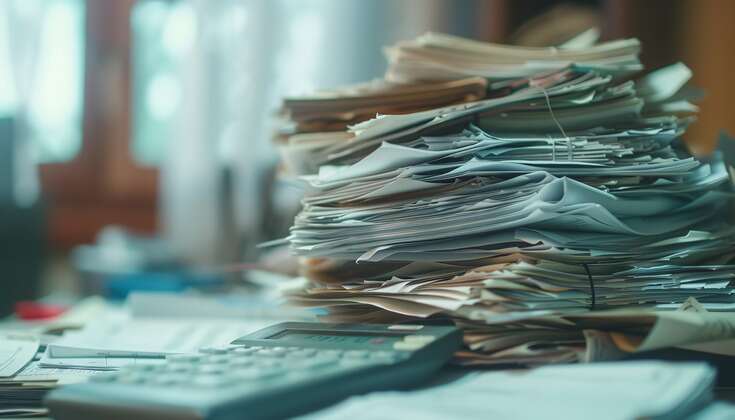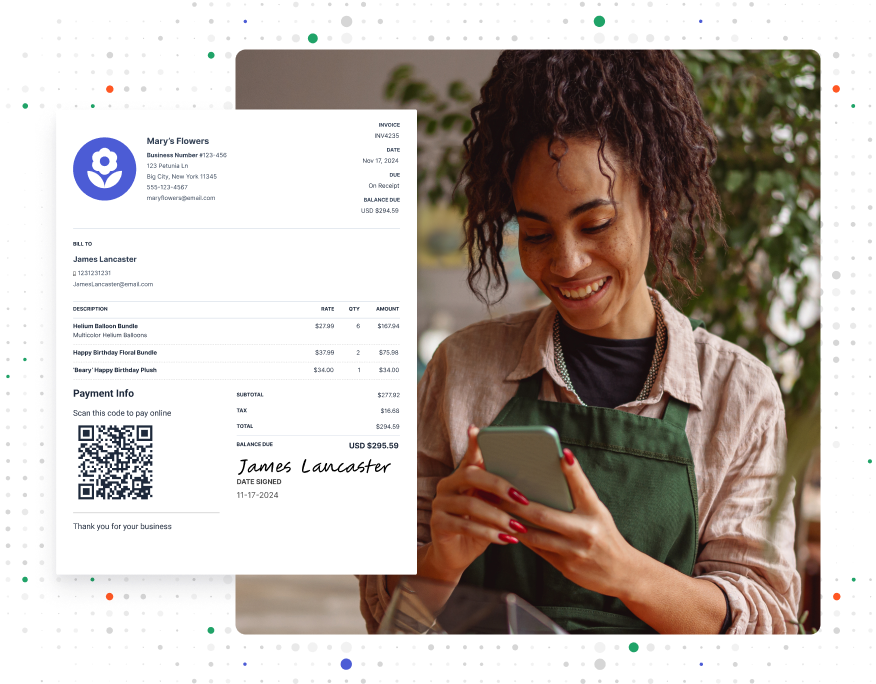Chart of Accounts: Sample, Definition, and Guide

Navigating your business’s finances can feel like exploring an unfamiliar city. A well-designed chart of accounts is the map that guides you through the winding streets of your company’s financial landscape.
A chart of accounts lists all the financial accounts your business uses. It helps you make sense of every dollar that flows in and out.
Here’s a chart of accounts sample, along with why it’s essential for your business.
What’s a Chart of Accounts?
A chart of accounts is a list of all of your business’s financial accounts, including expenses, revenue, and assets. It helps you organize and track the money moving in and out of your company. It’s usually in the form of a spreadsheet, detailing items like bank fees and accounts receivable.
Your chart of accounts provides a logical structure to sort and summarize all of your business’s funds. This creates a detailed map of your financial activities. You can see everything in the same place, which helps you spot potential problems and fix them before they affect your finances.
There can be some variation in charts of accounts by industry and business structure. But your goal is always to create an accurate snapshot of your company’s finances that’s easy to grasp at a glance. Getting it right from the start sets you up for smooth record-keeping and reporting.
How Does a Chart of Accounts Work?

Many accounting software programs rely on your chart of accounts to automate your books. When you sync your bank feed or submit a receipt, the software suggests an account to post it to. These accounts aren’t literal bank accounts, but categories that your expenses and revenue fall into. The process organizes your finances and makes sure every item has a place.
Each account gets a unique number. Think of this number like an address that shows an account’s location within the broader filing system. It lets you easily find and refer to each item when necessary.
Most charts of accounts include five main account types:
- Assets are resources your business owns that have monetary value, like cash, inventory, and equipment.
- Liabilities are your debts and obligations, such as loans, accounts payable, and taxes.
- Equity is the owner’s investment and retained earnings, representing their stake in the company.
- Revenue is the money you earn from selling products or services. In other words, it’s your income.
- Expenses track the costs of running your business. Chart of accounts expense categories include salaries, rent, and supplies.
Over time, the balances in each account accumulate. This lets you see totals and trends at a glance. The data becomes the basis for generating key financial statements and reports, like your balance sheet and income statement. It keeps your accounting cycles organized.
RELATED ARTICLE — What Is a Commercial Invoice?
The Importance of a Chart of Accounts
A well-organized chart of accounts serves as the backbone of your entire accounting system. With a properly structured chart, you can:
- Maintain Accurate, Organized Records. Transactions are less likely to be misplaced or entered incorrectly.
- Understand Your Business’s Financial Health. Account balances and changes over time uncover trends and measure performance.
- Simplify Tax Preparation. Accounts often align with tax reporting requirements. This makes it easier to fill out returns and claim deductions.
- Aid Financial Analysis and Decision-Making. Sorted data helps you look at your profitability, create budgets, and identify areas to cut costs or invest more funds.
- Streamline Reporting to Investors and Lenders. Well-documented financials build confidence and can help you secure funding.
Understanding the Layout of a Chart of Accounts
Here’s a closer look at the primary components of most charts of accounts:
1. Asset Accounts
Assets are resources your business owns that have monetary value:
- Cash is the money in your business bank accounts and on hand.
- Accounts Receivable is what customers owe you for goods and services.
- Inventory includes raw materials, works-in-progress, and finished products.
- Property and Equipment is your land, vehicles, and machinery.
- Prepaid Expenses are advance payments for future services, like annual insurance premiums.
2. Liability Accounts
Liabilities are debts and obligations your business owes others:
- Accounts Payable is the money you owe suppliers for goods or services received.
- Business Loans are borrowed funds from banks, credit cards, and other lenders.
- Taxes Payable include income, sales, and other taxes.
- Accrued Expenses are incurred but not yet paid, like wages or interest.
- Unearned Revenue is advance payments from customers for goods or services you haven’t delivered yet.
3. Equity Accounts
If you own your business, equity represents your stake in it. This is the amount left after you subtract your liabilities from your assets. Equity accounts may include:
- Owner’s Capital is the owner’s investment in the business.
- Retained Earnings are profits reinvested in the business over time.
- Common Stock includes the shares that go to owners of a corporation.
- Preferred Stock includes the shares with unique claims on assets and earnings.
4. Revenue Accounts
- Sales Revenue is the income from your core business activities.
- Service Revenue is the income from providing services.
- Interest Revenue is the money earned on bank accounts, loans, or investments.
Revenue is the money your business earns from selling products or services:
5. Expense Accounts
Expenses are costs you have to pay to run your business:
- Cost of Goods Sold includes the direct costs to produce goods or provide services.
- Salaries and Wages are employee compensation.
- Rent includes the costs of leasing office, retail, or warehouse space.
- Utilities are electricity, gas, and internet costs.
- Depreciation refers to the decrease in an asset’s value over time. This could be due to wear and tear or industry updates.
- Marketing and Advertising include the costs of promoting your products or services.
- Office Supplies are consumable materials like paper, pens, and printer ink.
- Travel Expenses are the costs of business trips, like airfare, lodging, and meals.
- Professional Fees are payments to lawyers, accountants, and other experts.
FROM ONE OF OUR PARTNERS — Basic Accounting for Small Business: Your Questions, Answered
Chart of Accounts Example

Looking at a sample chart of accounts is a great way to see how they work and what yours should look like. Here’s an example for a small landscaping business:
| Account Number | Account Name | Type | Financial Statement | Balance |
| 1000 | Cash | Asset | Balance Sheet | $15,000 |
| 1100 | Accounts Receivable | Asset | Balance Sheet | $7,500 |
| 1200 | Equipment | Asset | Balance Sheet | $45,000 |
| 1300 | Vehicles | Asset | Balance Sheet | $30,000 |
| 2000 | Accounts Payable | Liability | Balance Sheet | $4,000 |
| 2100 | Equipment Loans | Liability | Balance Sheet | $25,000 |
| 2200 | Vehicle Loans | Liability | Balance Sheet | $20,000 |
| 3000 | Owner’s Equity | Equity | Balance Sheet | $48,500 |
| 4000 | Landscaping Services Revenue | Revenue | Income Statement | $60,000 |
| 4100 | Garden Maintenance Revenue | Revenue | Income Statement | $18,000 |
| 5000 | Employee Wages | Expense | Income Statement | $32,000 |
| 5100 | Equipment Maintenance | Expense | Income Statement | $3,500 |
| 5200 | Vehicle Fuel | Expense | Income Statement | $2,200 |
| 5300 | Advertising and Marketing | Expense | Income Statement | $1,800 |
| 5400 | Office Supplies | Expense | Income Statement | $600 |
| 5500 | Utilities | Expense | Income Statement | $950 |
Each account has a four-digit number. The first digit represents the account type: 1 for assets, 2 for liabilities, 3 for equity, 4 for revenue, and 5 for expenses.
This numbering system makes it easy to locate specific accounts. It also keeps the chart organized as the business grows and adds more accounts over time.
RELATED ARTICLE — How To Write an Invoice for Freelance Work
5 Best Practices for Setting Up Your Chart of Accounts

There’s no one-size-fits-all approach to setting up a chart of accounts. But following a few key principles creates a logical, efficient system tailored to your business. Here are some tips:
- Keep It Consistent. Establish a clear, coherent structure from the start, and stick to it. Consistent names, numbers, and categories will make your accounts easier to follow.
- Strike a Balance. Create enough accounts to capture meaningful financial details. But don’t make so many that they clutter your chart. Aim for an amount that aligns with your reporting and decision-making needs.
- Think Ahead. Anticipate your business’s future needs and build in room for growth. Consider which new accounts you might need as you expand, diversify, or pivot. A little foresight now can save you from major headaches later.
- Adapt to Your Industry. While most charts of accounts share core elements, yours should reflect the unique aspects of your sector. Research the specific revenue streams, expense types, and reporting norms for your field.
- Review Regularly. Set a cadence, like quarterly or annually, to assess your chart of accounts. Look for underused, duplicate, and outdated sections. Then, consolidate or remove them to keep your structure lean and current.
RELATED ARTICLE — How To Keep Track of Business Expenses
Business Expense Tracker
Expenses are a foundational category in any chart of accounts—no matter your business’s size or industry.
With Invoice Simple, tracking expenses has never been easier. Its business expense and receipt tracker lets you scan any receipt and capture key info automatically. All expense data is ready to export for an organized, up-to-date chart of accounts.
Start Your First
Invoice Today
Create customized and professional
invoices and connect with clients
